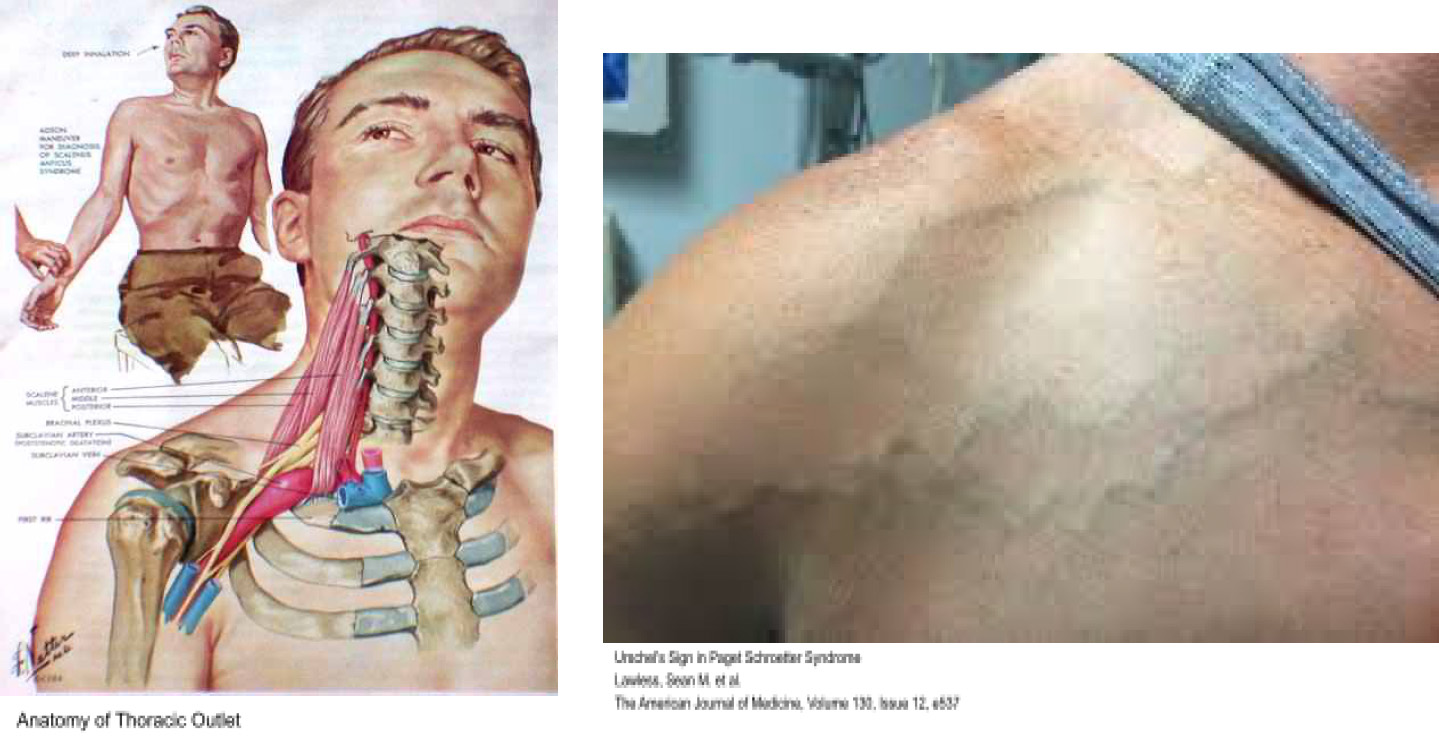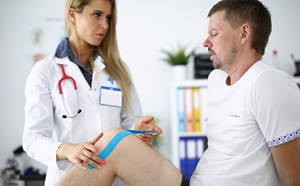
Paget-Schroetter Syndrome
Case prompt:
23 year old male presents to the Emergency Department with complaints of right sided neck pain, right arm pain and swelling. Patient states that the symptoms have been ongoing for the past 9 months. He is a pitcher for the local college team. He denies trauma or injury to his neck, shoulder or arm. The pain and swelling in the right upper extremity have been slowly getting worse over time, his neck pain has started recently. He states his arm feels heavy. He denies numbness in the right upper extremity, palpitations, headaches, dyspnea. He has no other medical problems and does not take any medications. He denies illicit drug, alcohol and tobacco use.
His vital signs are normal. His exam is pertinent for swollen right upper extremity that appears slightly larger than left upper extremity. Patient has full range of motion, no muscle weakness or instability on testing. No midline neck tenderness or exacerbation of pain on Spurlings or neck range of motion. Patient is neurologically intact and has 2+ radial and ulnar pulses. What is the most likely diagnosis?
- Superior Vena Cava Syndrome
- Cervical Radiculopathy
- Upper Extremity Lymphedema
- Paget-Schroetter Syndrome
- Upper Extremity Deep Vein Thrombosis
Answer: Paget-Schroetter Syndrome (PSS)
Background:
- Paget-Schroetter Syndrome is an effort-based thrombosis of the Axillary and Subclavian vein associated with compression of the Subclavian vein at the thoracic outlet.1,2,3
- Venous variant of Thoracic Outlet Syndrome (TOS)
- Seen in younger adults (20-30s) with a 2:1 M:F ratio11
- Most of these are athletes who perform repetitive overhead movements
- Venous Thoracic Outlet Syndrome is the rarest of the the etiologies of Thoracic Outlet Syndrome11
- 1-2 per 100,000 are reported
Pathophysiology:
- Subclavian vein traverses between the first rib, clavicle, and the anterior scalene muscle5
- Repetitive physical activity and compression can lead to compression and subsequent venous injury/thrombosis
- This can lead to decreased venous return and extremity edema and pain
- Overtime, collateral venous flow will bypass the area of thrombosis11
- Inflammation from the thrombosis can lead to vein collapse and scar tissue formation
Clinical Presentation:
- Patients will present with worsening upper extremity edema and pain
- Can be acute, subacute or chronic during presentation
- Typically, an inciting, strenuous exercise will precede symptoms and can be elicited from History of Present Illness
- On exam, affected arm will be edematous and appear enlarged in comparison to contralateral side
- Can appear tense and cyanotic
- Urschel’s sign may be present
- Venous colaterals present around the shoulder and chest10
- Arm will feel heavy to the patient, but range of motion and muscle strength will be intact
- Confirm neurovascular status of affected extremity

Diagnosis:
- Confirm presence of coagulation disorders in family history or past medical history
- Upper Extremity ultrasound can assess for Deep Vein Thrombosis (DVT), collapsed veins and chronic clot burden11
- Computerized Tomography (CT) Venography and Magnetic Resonance (MR) Venography is better suited for eval of central venous system
- Laboratory workup should include thrombophilia panel (Proteins C&S, antithrombin levels, Factor V Leiden mutation testing, etc) along with D-Dimer levels11
- If patient has signs and symptoms of Pulmonary Embolism (tachycardia, tachypnea, hypoxia), include a CT Angiogram of the chest
Management:
- Surgical decompression along with anticoagulation has 90% successful treatment 4,9,11
- First Rib resection along with optional resection of surrounding structures to decompress the thoracic outlet7
- Anticoagulation can be utilized as well 6,8
- Intravenous Heparin preoperatively and short course dual oral anticoagulant post-op
DDx:
- Lymphedema, Deep Vein Thrombosis, Acute Arterial Ischemia, Congestive Heart Failure, Superior Vena Cava syndrome, Neurogenic Claudication, Cervical Radiculopathy, Thoracic Malignancy
Clinical Pearls:
- Thoracic Outlet Syndrome (TOS) affects many athletes, especially ones with repetitive motion in their sport
- Venous variants are less prevalent then neurogenic and arterial TOS
- Patient will present with more insidious onset including heaviness, pain and edema
- Always assess neurovascular status
- During initial workup, evaluate for thrombophilia and rule out signs and symptoms of a Pulmonary Embolism
- Gold standard treatment is surgical decompression but oral anticoagulation can aid in management
References:
- Sayın A, Güngör H, Bilgin M, Ertürk U. Paget-von Schrötter syndrome: upper extremity deep vein thrombosis after heavy exercise. Turk Kardiyol Dern Ars. 2012 Jun;40(4):354-7.
- 2. Zell L, Sommerfeld A, Buchter A. [The Paget-von Schroetter syndrome. On the centenary of the death of Sir James Paget and on the 50th anniversary of the naming of the syndrome]. Dtsch Med Wochenschr. 1999 Aug 06;124(31-32):948-51.
- 3. Thiyagarajah K, Ellingwood L, Endres K, Hegazi A, Radford J, Iansavitchene A, Lazo-Langner A. Post-thrombotic syndrome and recurrent thromboembolism in patients with upper extremity deep vein thrombosis: A systematic review and meta-analysis. Thromb Res. 2019 Feb;174:34-39.
- 4. Kumar R, Harsh K, Saini S, O'Brien SH, Stanek J, Warren P, Giver J, Go MR, Kerlin BA. Treatment-Related Outcomes in Paget-Schroetter Syndrome-A Cross-Sectional Investigation. J Pediatr. 2019 Apr;207:226-232.
- 5. Chen AWY, Oraii Yazdani K, Candilio L. Upper Limb Deep Vein Thrombosis: A Case Report of an Increasingly Common Condition. J Tehran Heart Cent. 2018 Apr;13(2):73-75.
- 6. im W, Le Gal G, Bates SM, Righini M, Haramati LB, Lang E, Kline JA, Chasteen S, Snyder M, Patel P, Bhatt M, Patel P, Braun C, Begum H, Wiercioch W, Schünemann HJ, Mustafa RA. American Society of Hematology 2018 guidelines for management of venous thromboembolism: diagnosis of venous thromboembolism. Blood Adv. 2018 Nov 27;2(22):3226-3256.
- 7. Wooster M, Fernandez B, Summers KL, Illig KA. Surgical and endovascular central venous reconstruction combined with thoracic outlet decompression in highly symptomatic patients. J Vasc Surg Venous Lymphat Disord. 2019 Jan;7(1):106-112.e3.
- 8. Gwozdz AM, Silickas J, Smith A, Saha P, Black SA. Endovascular Therapy for Central Venous Thrombosis. Methodist Debakey Cardiovasc J. 2018 Jul-Sep;14(3):214-218.
- 9. Kärkkäinen JM, Nuutinen H, Riekkinen T, Sihvo E, Turtiainen J, Saari P, Mäkinen K, Manninen H. Pharmacomechanical Thrombectomy in Paget-Schroetter Syndrome. Cardiovasc Intervent Radiol. 2016 Sep;39(9):1272-9.
- 10. Garg V, Poon G, Tan A, Poon KB. Paget-Schroetter syndrome as a result of 1st rib stress fracture due to gym activity presenting with Urschel's sign - A case report and review of literature. Int J Surg Case Rep. 2018;49:81-86.
- 11. Saleem T, Baril DT. Paget-Schroetter Syndrome. [Updated 2023 Apr 26]. In: StatPearls [Internet]. Treasure Island (FL): StatPearls Publishing; 2025 Jan-. Available here.



